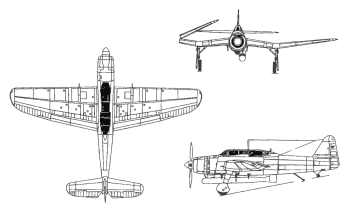



The Aichi B7A Ryusei (Shooting Star) was one of the largest and most effective Japanese carrier-based aircraft of the war. Designed as a multi-purpose aircraft capable of both torpedo and dive bombing, it was to eventually replace the 'Jill' and 'Judy' in these roles respectively. The B7A had excellent maneuvrability (equal to many fighters) despite its size, a high rate of climb, and speed superior to that of the A6M Zero but was its development was hampered by a troublesome engine which delayed its entry until the second half of 1944, well after Japan had lost command of the air over the Pacific, most of its carriers had been sunk, and Japanese industry was being put to the limits by the increasing ferocity of B-29 raids. As such, the B7A was produced in minimal quantities and ended up equipping only two land-based units during the final months of the war. Worse still, the Aichi Funakata plant which built it was leveled by a powerful earthquake in May 1945.
First flight of the prototype B7A1 took place sometime in May 1942 but development was significantly delayed due to problems with the Homare engine. Production versions were known as the B7A2 and were produced by both Aichi and the Omura Naval Air Arsenal. No other variants were built although an improved B7A3 model with an uprated Homare 23 engine was on the drawing boards but never flown.
Preceded by:
NoneSucceeded by:
None | |
| Design | B7A2 |
| Name | Ryusei |
| Code Name | Grace |
| Type | Torpedo Bomber |
| Year | 1944 |
| Crew | 2 |
| Dimensions | |
| Length | 37 ft 8½ in |
| Height | 13 ft 5 in |
| Wing Span | 47 ft 3 in |
| Wing Area | n/a |
| Weight | |
| Empty | 8,400 lbs |
| Maximum | 14,330 lbs |
| Wing Loading | 37.6 lb/ft² |
| Performance | |
| Speed | 352 mph |
| Ceiling | 29,364 ft |
| Range | 1,150-1,889 mi |
| Powerplant | |
| Engine | 1 x NK9C Homare 12 Nakajima 1,825 hp |
| Thrust/Weight | 0.44 |
| Armament | |
| Guns | 2 x 20-mm 1 x 7.92/13-mm |
| Payload | 1,764 lbs |
| Production | |
| Built | 105 |
| Total | 114 |